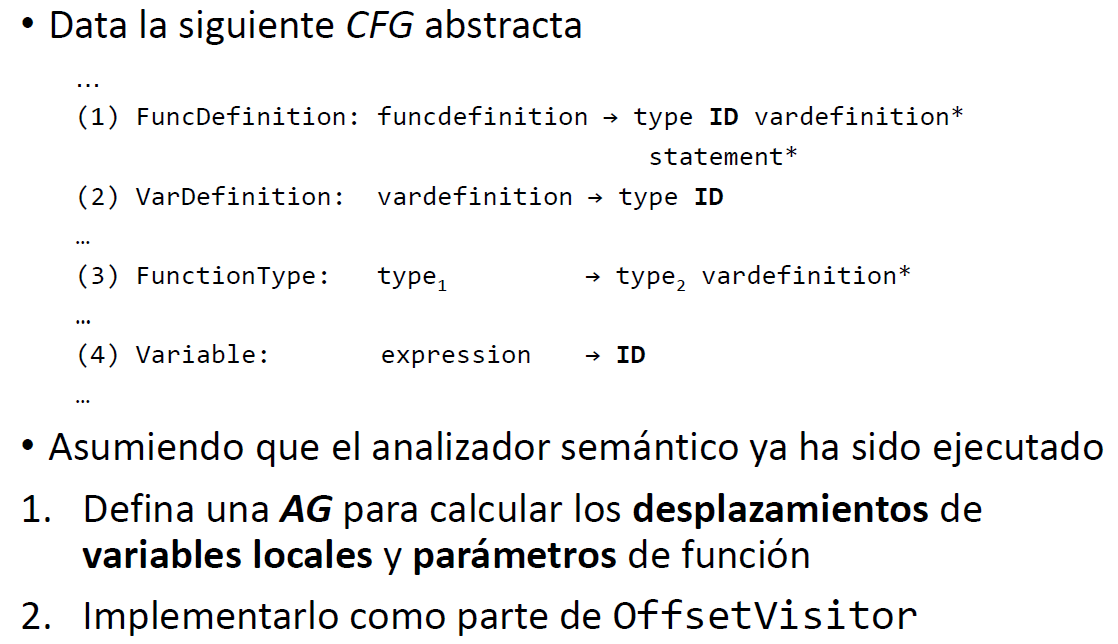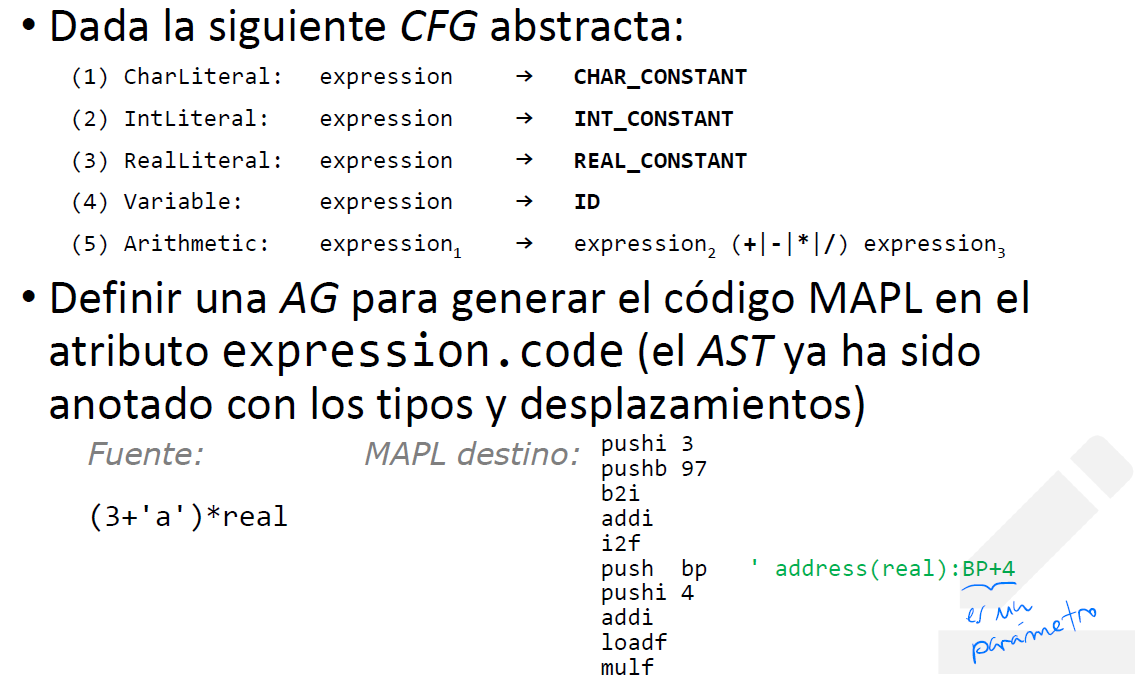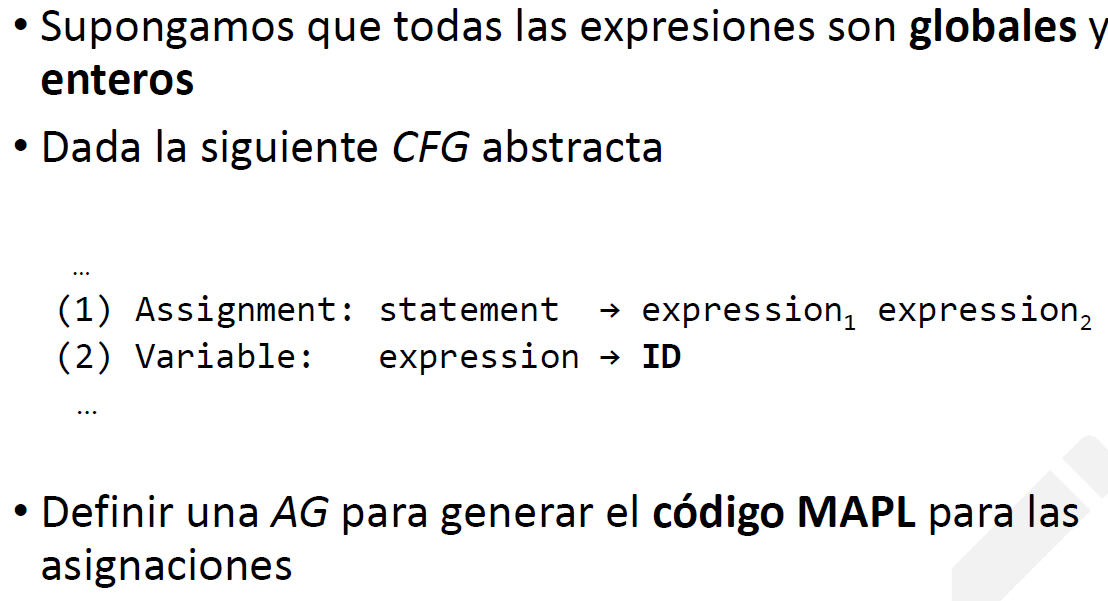Léxico
- Hacer el analizador léxico del siguiente lenguaje usando ANTLR.
edad = 65; # Comentario de una línea
print a
read b;
print "fin"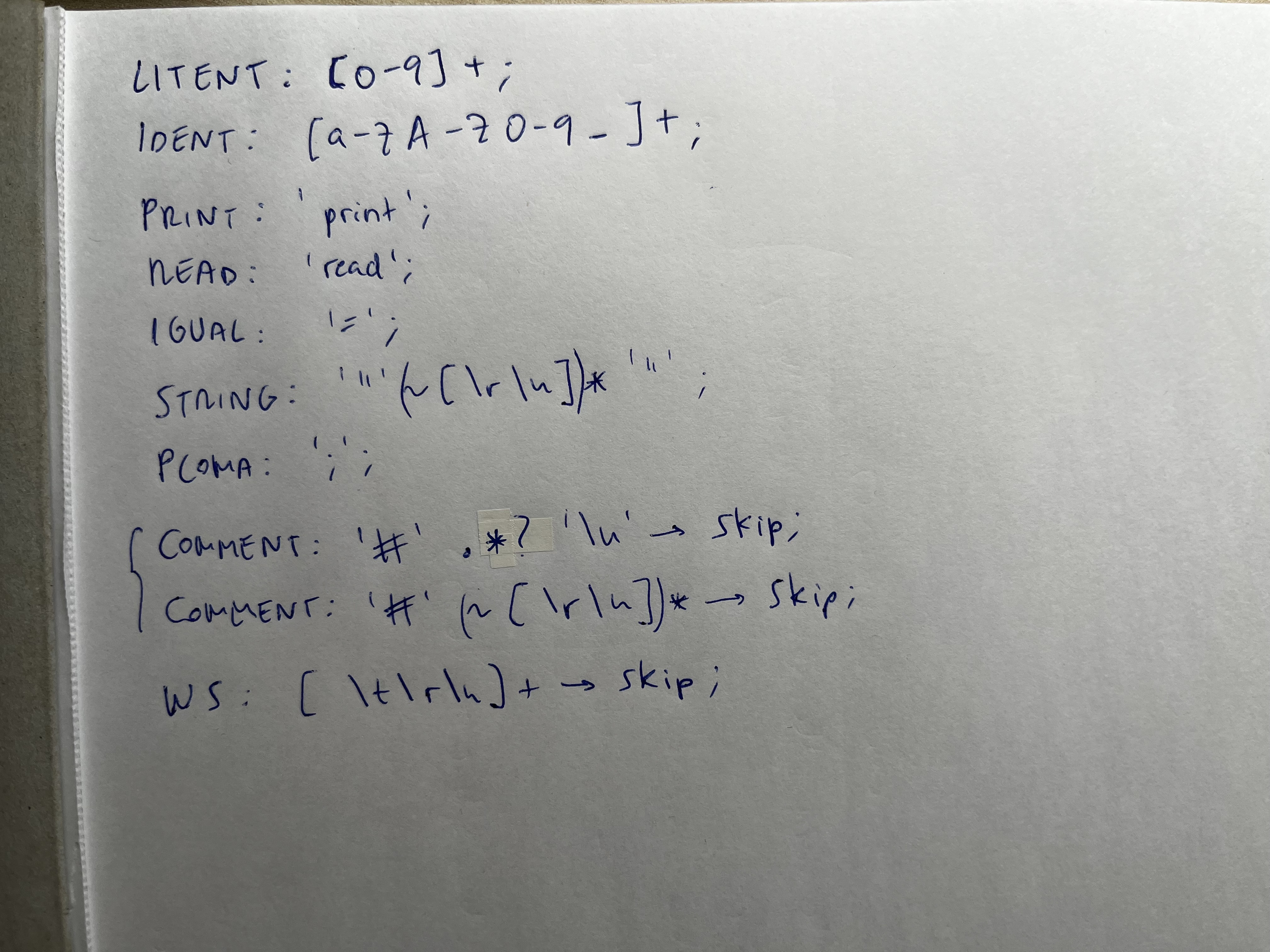
Sintáctico
- Hacer el árbol AST:
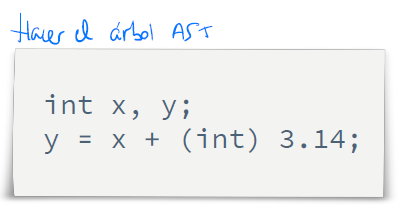
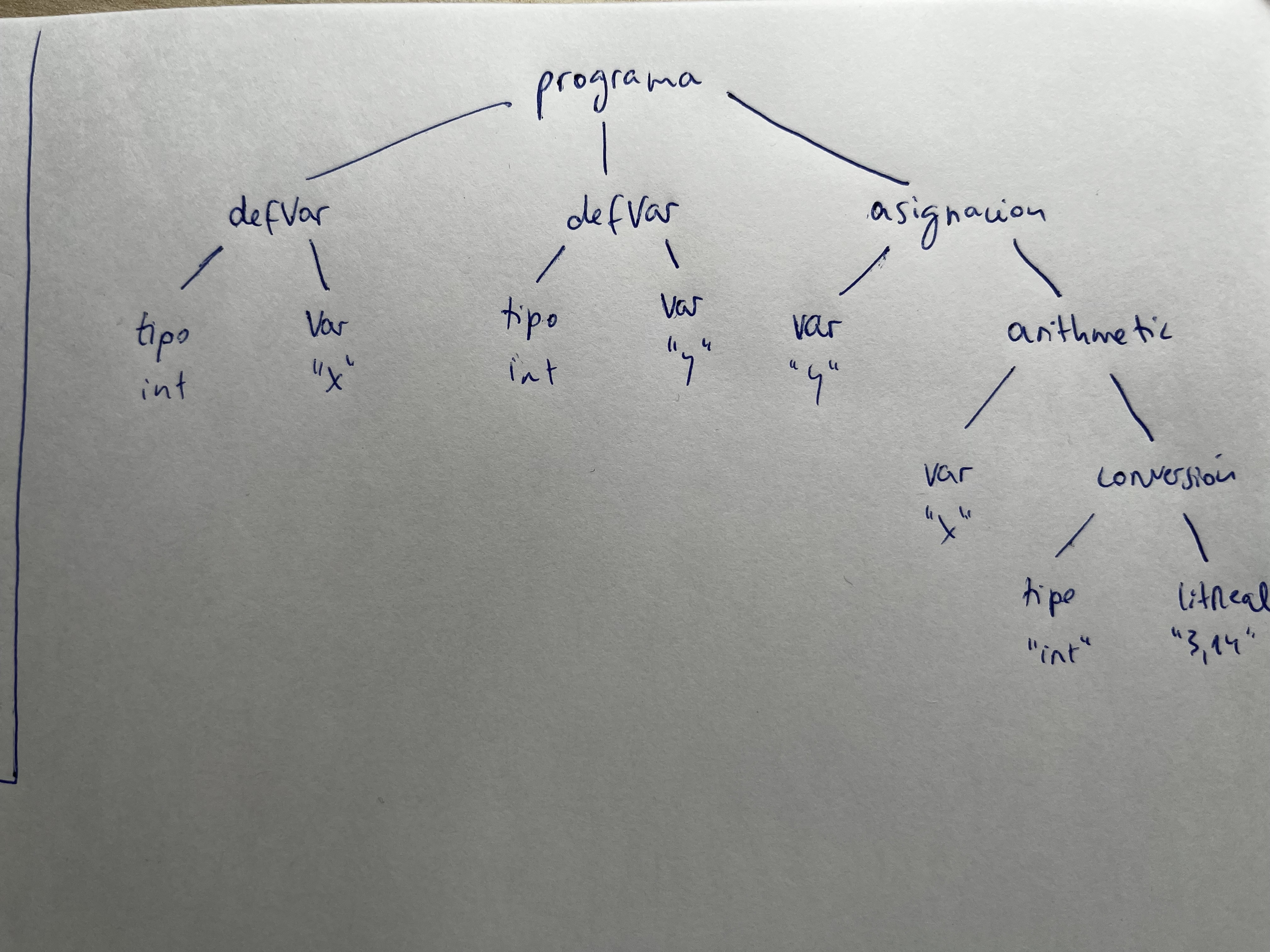
- Decir si es una sentencia válida y hacer el árbol concreto:

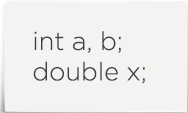
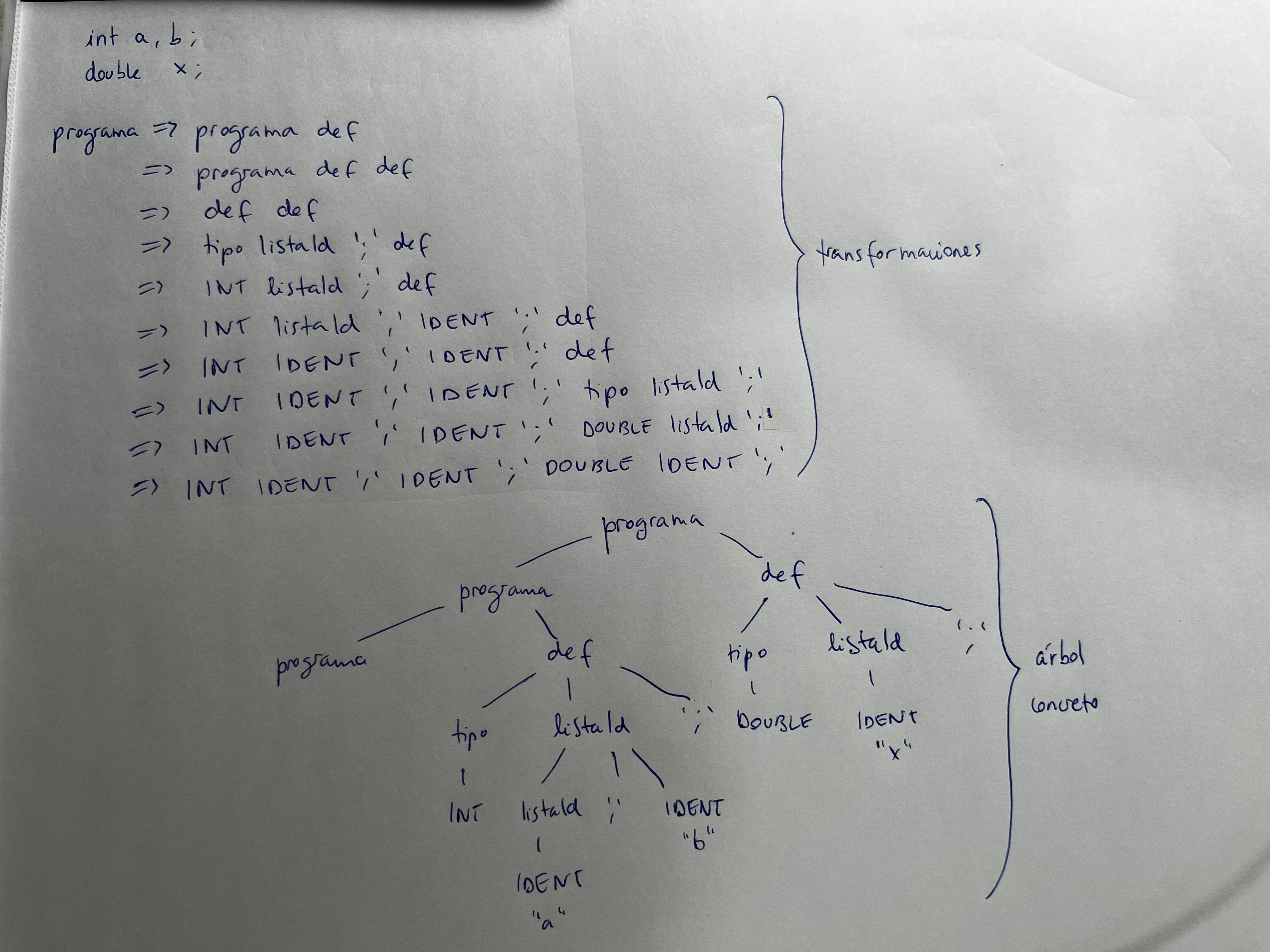
- Dada la siguiente gramática, implementar un parser de la misma utilizando la técnica recursiva descendente.
prog ⟶ decl decl
decl ⟶ variables | typedef
variables ⟶ VAR IDENT restoIdents
restoIdents ⟶ ‘,’ IDENT restoIdents
| ‘:’ tipo
tipo ⟶ INT | FLOAT
typedef ⟶ TYPE IDENT restoIdentspublic class RecursiveParser {
private Lexicon lex;
private Token token;
public RecursiveParser(Lexicon lex) throws ParseException{
this.lex = lex;
advance();
}
private void advance(){
tokent = lex.nextToken();
}
private void error() throws ParseException{
throw new ParseException("Error sintáctico.");
}
void match(int tokenType) throws ParseException{
if(token.getType() == tokenType)
advance();
else
error();
}
//--------
public void prog() throws ParseException {
decl();
decl();
match(Lexicon.EOF);
}
void decl() throws ParseException {
if (token.getType() == Lexicon.VAR)
variables();
else if (token.getType() == Lexicon.TYPE)
typedef();
else
error();
}
void variables() throws ParseException {
match(Lexicon.VAR);
match(Lexicon.IDENT);
restoIdents();
}
void restoIdents() throws ParseException {
if (token.getType() == Lexicon.COMA) {
match(Lexicon.COMA);
match(Lexicon.IDENT);
restoIdents();
} else if (token.getType() == Lexicon.PUNTOS) {
match(Lexicon.PUNTOS);
tipo();
} else
error();
}
void tipo() throws ParseException {
if (token.getType() == Lexicon.INT)
match(Lexicon.INT);
else if (token.getType() == Lexicon.FLOAT)
match(Lexicon.FLOAT);
else
error();
}
void typedef() throws ParseException{
match(Lexicon.TYPE);
match(Lexicon.IDENT);
restoIdents();
}
}- Hacer una especificación ANTLR para un lenguaje con las siguientes características:
-
Una entrada tendrá sólo una única sentencia ‘print’ seguida de una expresión y un punto y coma.

-
Primero implementamos el léxico del lenguaje:
lexer grammar Lexicon;
NUM : [0-9]+;
IDENT : [a-zA-Z0-9_]+;
WS : [ \t\r\n]+ -> skip;- Ahora la gramática:
grammar Grammar;
import Lexicon;
start : 'print' expr ';';
expr:
NUM
| IDENT
| '(' expr ')'
| expr ('*' | '/') expr
| expr ('+' | '-') expr
| expr ('==' | '!=') expr
| expr '&&' expr
| expr '||' expr
;- Crear la gramática abstracta para el lenguaje del ejemplo.
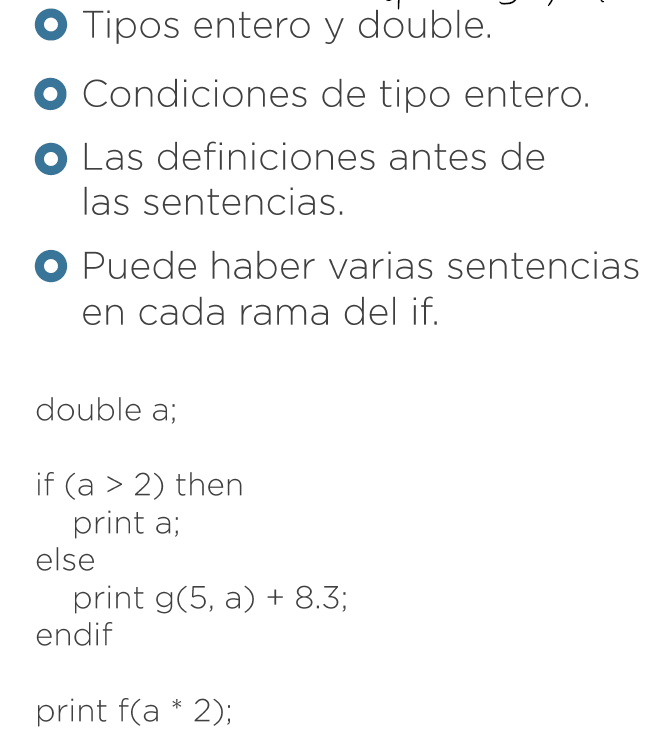
programa ⟶ defVariable* sentencia*
defVariable ⟶ nombre:string tipo
intType:tipo ⟶ ε
realType:tipo ⟶ ε
escritura:sentencia ⟶ expresion
if:sentencia ⟶ condicion:expresión cierto:sentencia* falso:sentencia*
exprBinaria:expresion ⟶ left:expresión operator:string right:expresion
invocacion:expresion ⟶ nombre:string args:expresion*
variable:expresion ⟶ lexema:string
literalInt:expresion ⟶ lexema:string
literalReal:expresion ⟶ lexema:string- Dada la siguiente especificación sintáctica en ANTLR y la gramática abstracta que define los nodos del AST, añadir la especificación de ANTLR el código que cree el AST de las entradas: Abstracta:
programa ⟶ definicion print;
definicion ⟶ tipo nombre:string;
tipoInt:tipo ⟶ ;
tipoReal:tipo ⟶ ;
print ⟶ expr:expresion;
variable:expresion ⟶ nombre:string;
literalEntero:expresion ⟶ valor:string;
Gramática
start
: definicion print EOF
;
definicion
: tipo IDENT ';'
;
tipo
: 'int'
| 'float'
;
print
: 'print' expr ';'
;
expr
: IDENT
| LITENT
;El parser sería:
@parser::header {
import ast.*;
}
start returns[Programa ast]
: definicion print EOF { $ast = new Programa($definicion.ast, $print.ast); }
;
definicion returns[Definicion ast]
: tipo IDENT ';' { $ast = new Definicion($tipo.ast, $IDENT.text); }
;
tipo returns[Tipo ast]
: 'int' { $ast = new TipoInt(); }
| 'float' { $ast = new TipoReal();}
;
print returns[Print ast]
: 'print' expr ';' { $ast = new Print($expr.ast); }
;
expr returns[Expresion ast]
: IDENT { $ast = new Variable($IDENT.text); }
| LITENT { $ast = new LiteralEntero($LITENT.text); }
;- Hacer una gramática en BNF de un lenguaje con las siguientes características:
- Un conjunto está formado por uno o más elementos entre paréntesis separados por comas.
- Cada elemento puede ser un número u otro conjunto.
- Los números están formados por dígitos de 1 al 3, pudiendo haber espacios entre ellos. Suponer que el analizador léxico devuelve los tokens UNO, DOS y TRES.
- Los números están formados por un número impar de dígitos y son capicúa.
Ejemplos de entradas válidas serían:
(131)
(3, 222, 12 313)
(12121, 2, (333), (2, 3, 1111111))
(2132312, ( ( (1, 2), 2, 131), 1, 2), 3322233)
Se pide hacer una gramática BNF usando las construcciones anteriores. Anotar en cada regla qué construcción sigue.
conjunto: '(' elementos ')' // Secuencia
elementos: elemento | elementos ‘,’ elemento // Lista
elemento: num | conjunto // Dos secuencias
num: UNO // Composición
| DOS
| TRES
| UNO num UNO
| DOS num DOS
| TRES num TRES- Sea un lenguaje para la definición de variables.
int a, b;
double x;Requisitos:
- Sólo hay dos tipos: entero (int) y real (double).
- En una sola definición, pueden definirse varias variables del mismo tipo.
- En un programa puede haber varias definiciones, pero también sería válido que no hubiera ninguna.
Se pide especificar la sintaxis de dicho lenguaje en BNF y en EBNF.
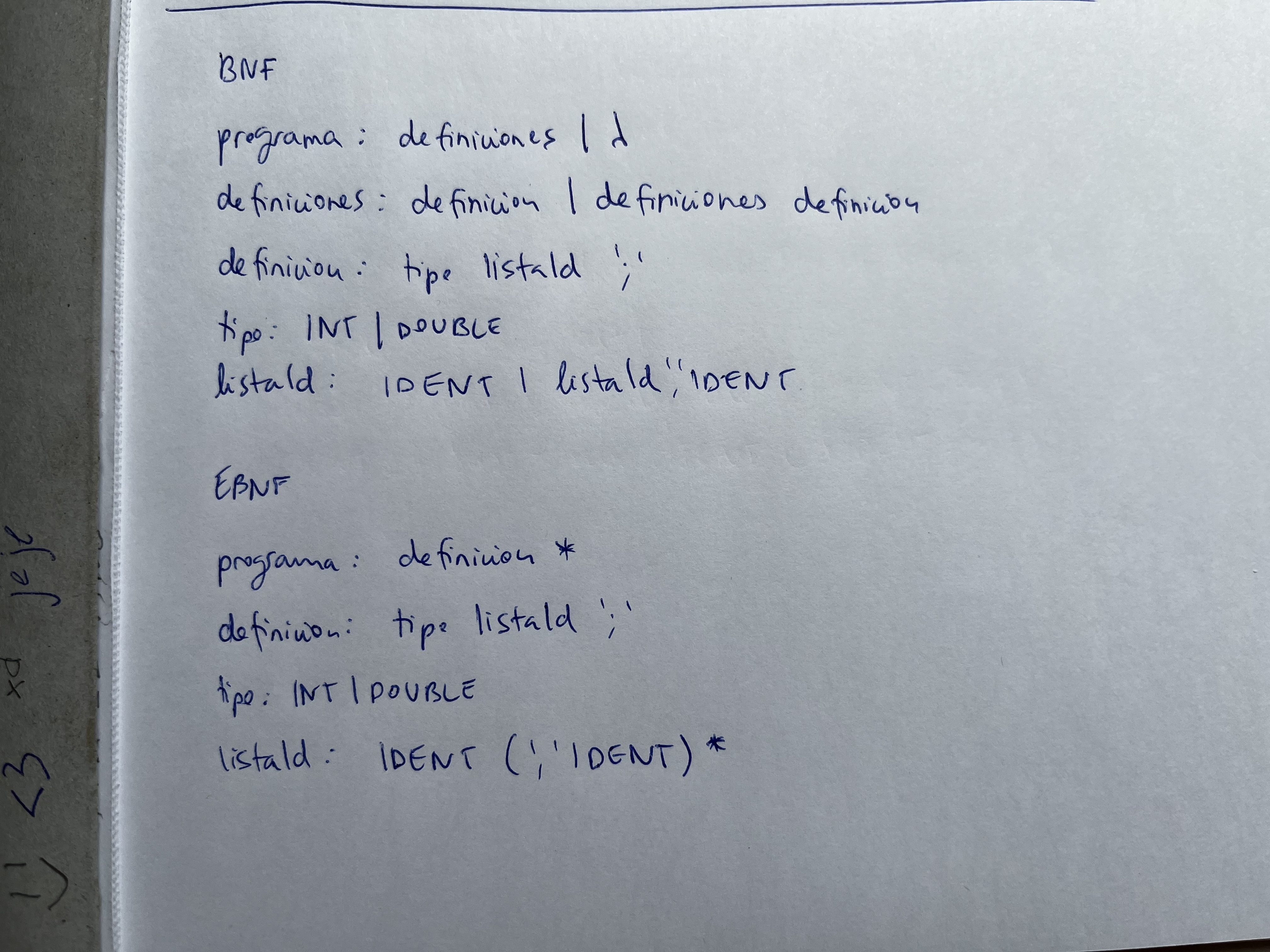
- Dada la gramática en ANTLR y la gramática abstracta siguientes, añadir al fichero de ANTLR las acciones que construyan el AST.
start
: sentences EOF
;
sentences
: sentence*
;
sentence
: 'print' expr ';'
| left=expr '=' right=expr ';'
;
expr
: left=expr op=('*' | '/') right=expr
| left=expr op=('+' | '-') right=expr
| '(' expr ')'
| IDENT
;program → sentences:sentence*;
print:sentence → expression;
assignment:sentence → left:expresión right:expression;
arithmetic:expression → left:expresión operator:string right:expression;
variable:expression → name:string;Solución:
start returns[Program ast]
: sentences EOF { $ast = new Program($sentences.list); }
;
sentences returns[List<Sentence> list = new ArrayList<Sentence>()]
: (sentence { $list.add($sentence.ast); })*
;
sentence returns[Sentence ast]
: 'print' expr ';' { $ast = new Print($expr.ast); }
| left=expr '=' right=expr ';' { $ast = new Assignment($left.ast, $right.ast); }
;
expr returns[Expression ast]
: left=expr op=('*' | '/') right=expr { $ast = new Arithmetic($left.ast, $op.text, $right.ast); }
| left=expr op=('+' | '-') right=expr { $ast = new Arithmetic($left.ast, $op.text, $right.ast); }
| '(' expr ')' { $ast = $expr.ast; }
| IDENT { $ast = new Variable($IDENT.text); }
;Semántico



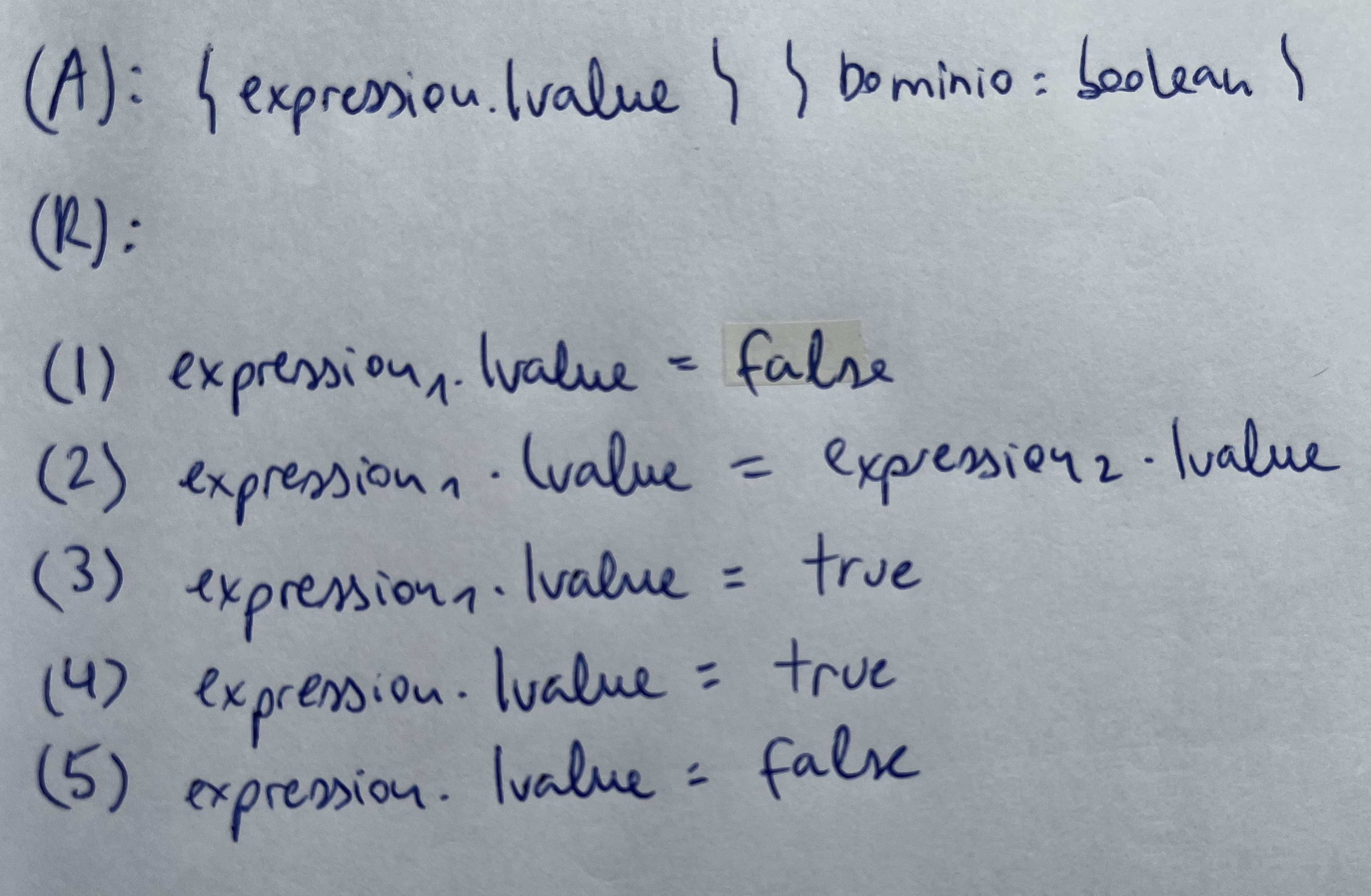
- Dada la siguiente CFG, definir una gramática atribuida para realizar la fase de Identificación. Nota, se puede usar el objeto st del ejercicio anterior.
(G):


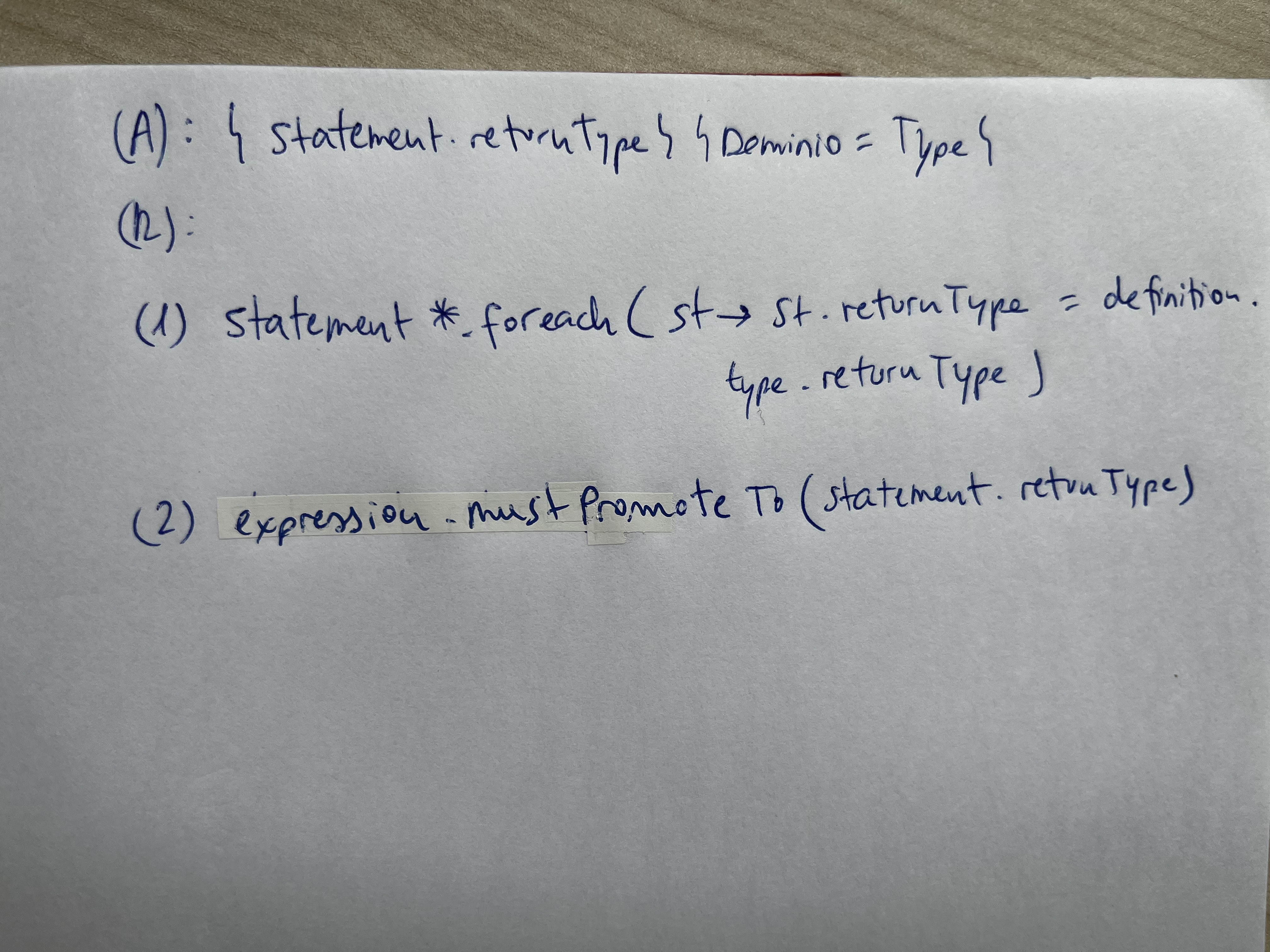
- Comprobar que las funciones tengan return en la siguiente gramática. Crear la AG correspondiente:

Solución:

Generación de código
- Dado el siguiente programa de alto nivel:
a = 3;
b = a;Escribir el código destino MAPL. Suponer que:
- Las direcciones de memoria de a y b son 0 y 2
- Ambas son variables enteras
PUSHA 0 //meto una direccion
PUSHI 3 //meto un 3 ocupando 2 bytes
STOREI //escribo un 3 ocupando 2 porciones de memoria
PUSHA 2
PUSHA 0
LOADI //va a la dirección 0 y lo deja en el tope de la pila
STOREI//read myInteger;
pusha 0
ini
storei
//real = myInteger * 3.4 -7;
pusha 2
pusha 0
loadi
i2f
pushf 3.4
mulf
pushi 7
i2f
subf
storef
//write real;
pusha 2
loadf
outf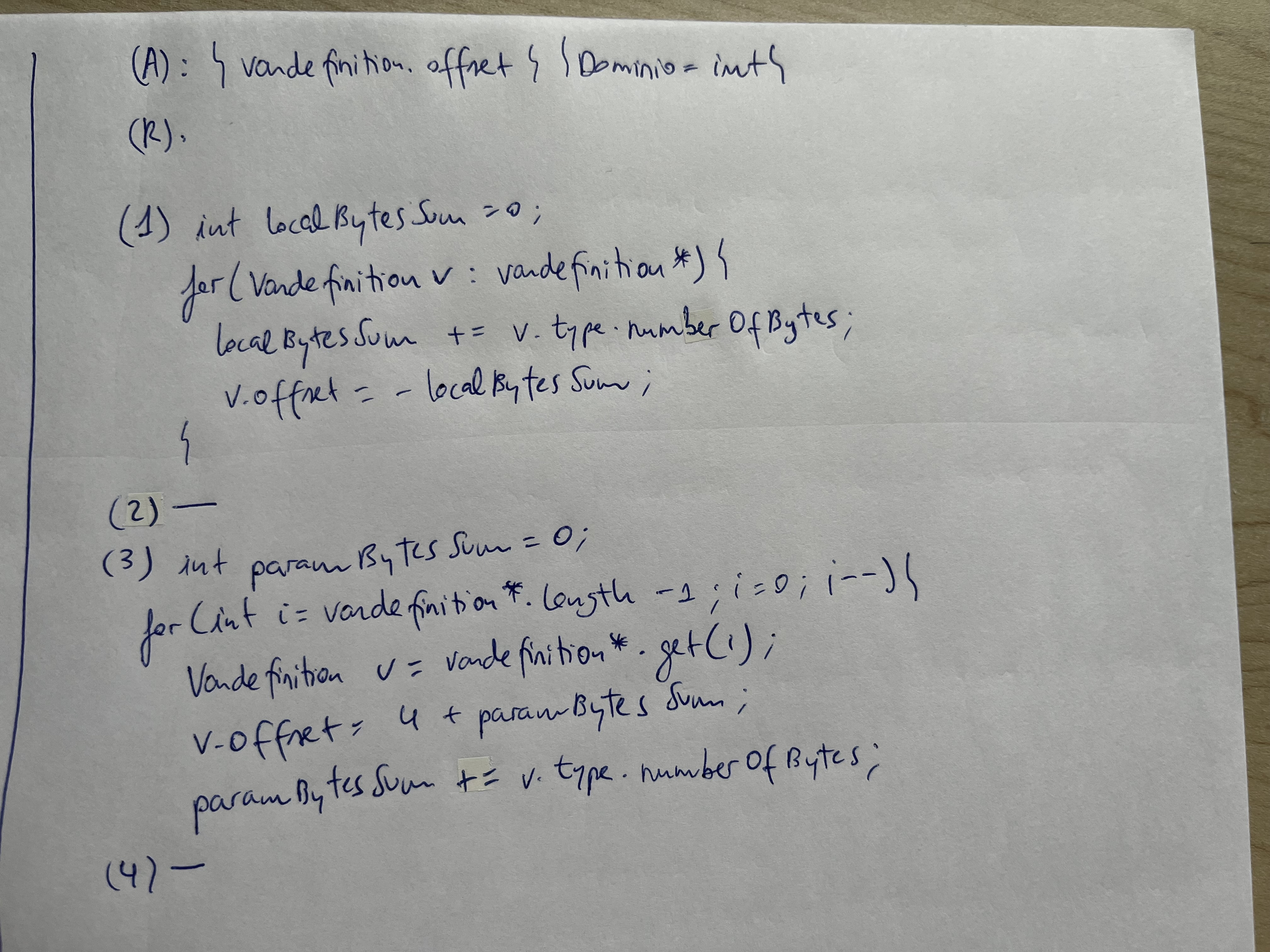
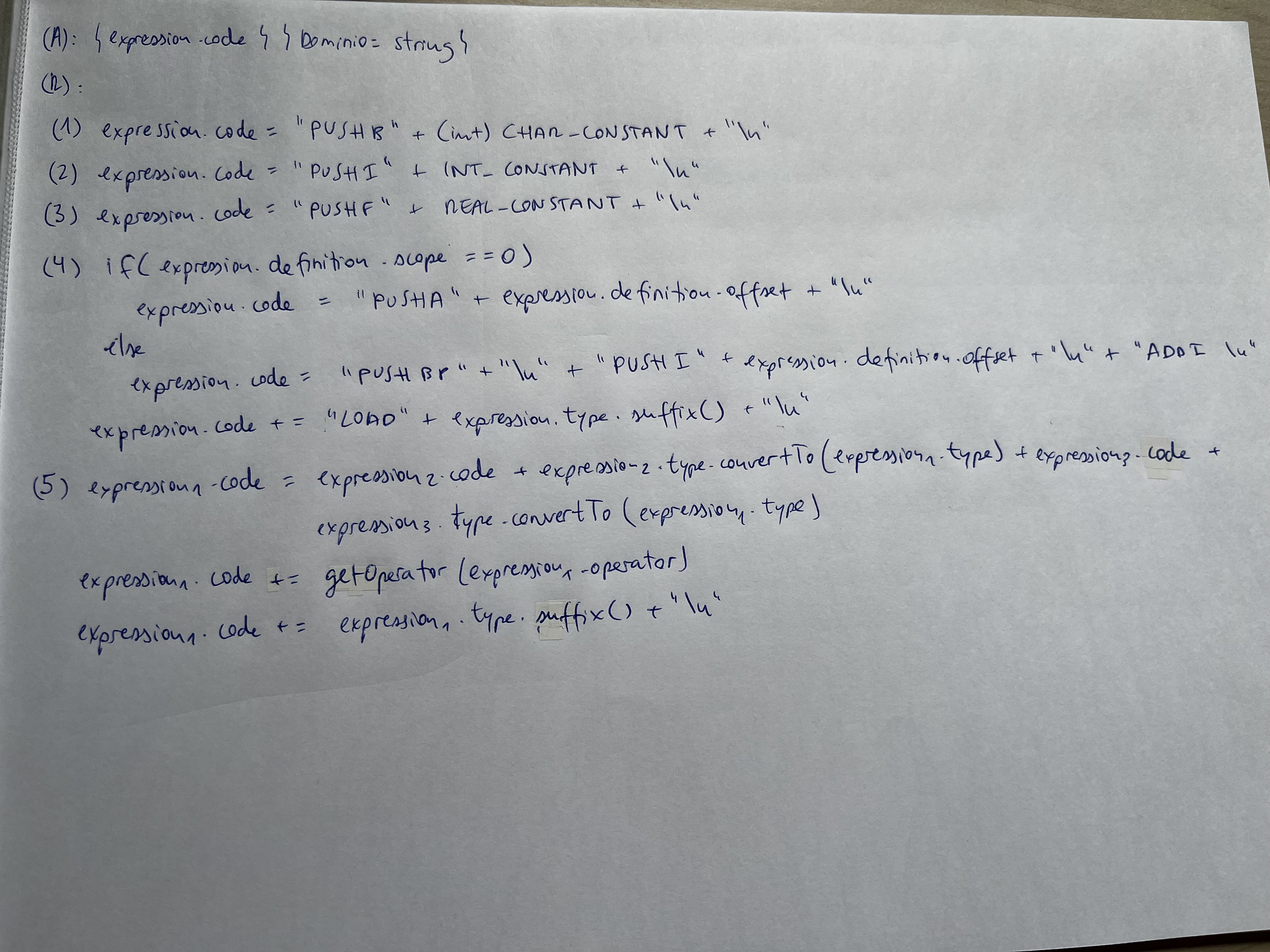
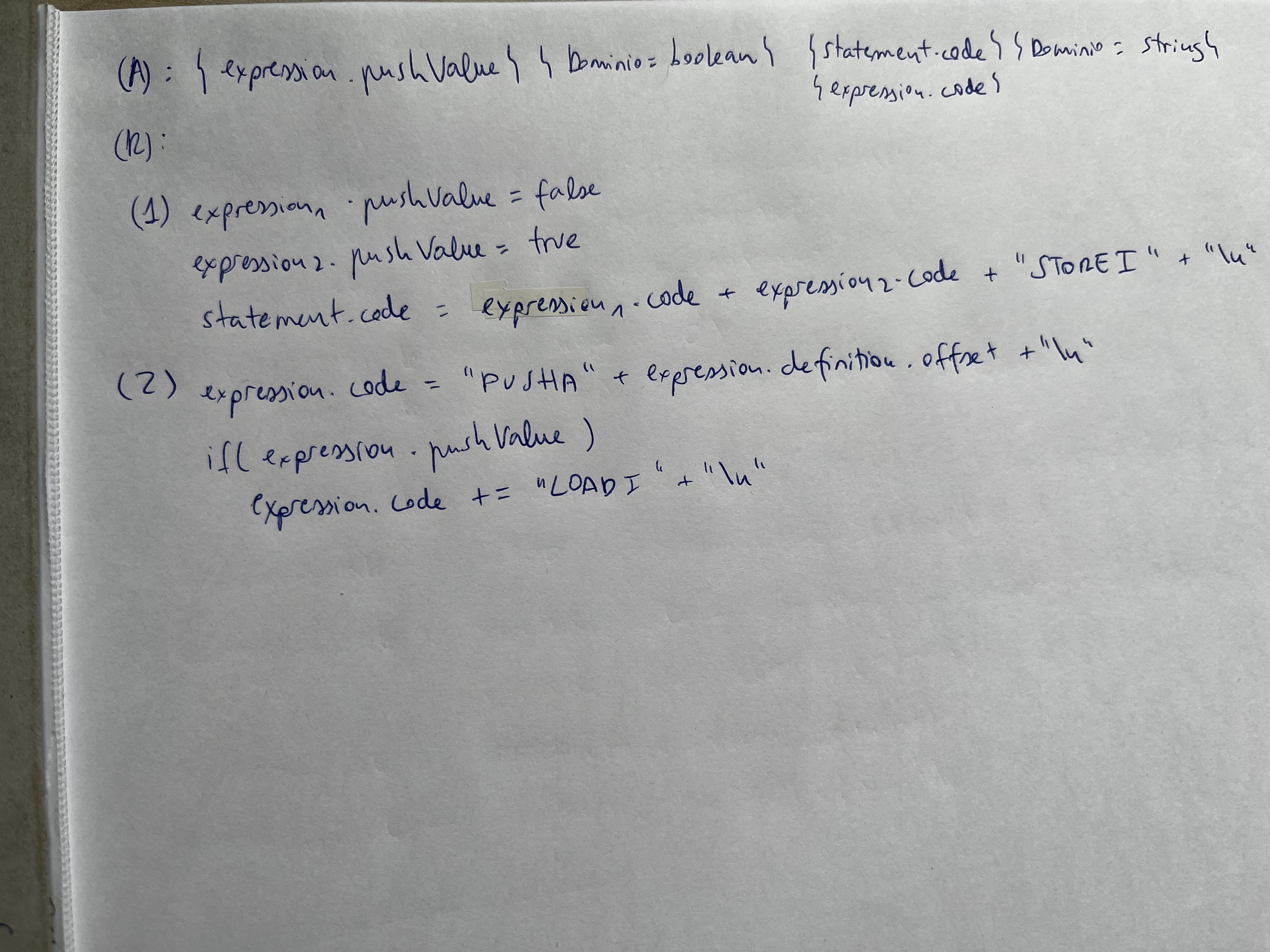
-
Implementar las plantillas de código para las asignaciones. Usar la (G) del ejercicio anterior.

-
Define las plantillas de código para apilar el valor de las siguientes expresiones:


- Especificar las plantillas de código de los arrays.


Estas plantillas vienen de esta explicación:

-
Especificar las plantillas de código para calcular las direcciones de memoria de los campos de los registros


-
Escribir la plantilla de código de un bucle While.

-
Escribir la plantilla de código de un bucle Do/While.

-
Escribir la plantilla de código de un bucle For.
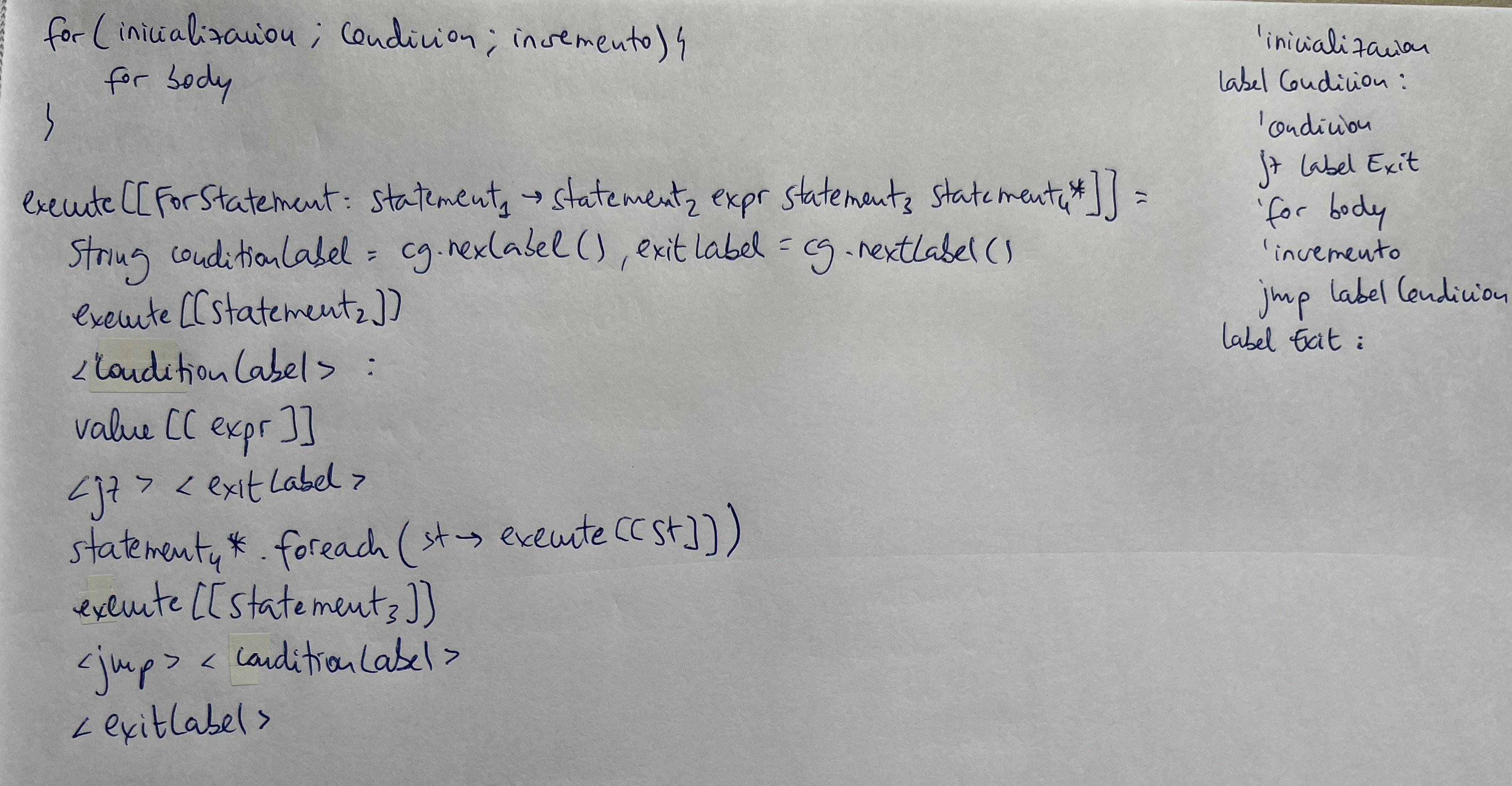
-
Escribir la plantilla de código de un If/Else.

-
Escribir las plantillas de código para la invocación de funciones.

-
Switch:
/**
* execute[[Switch: statement -> expression statement* case*]]() =
* int labelFinal = cg.getLabel() //finalSwitch
* case*.forEach(c -> {
* int labelCase = cg.getLabel()
* c.labelCase = labelCase
* <label> labelCase
* value[[expression]]
* execute[[c]]
* c.labelFinalSwitch = labelFinal
* });
* int label1 = cg.getLabel() //default
* <label> label1
* statement*.forEach(s -> execute[[s]])
* <label> labelFinal
* @param e
* @param t
* @return
*/
@Override
public Void visit(Switch e, FuncDefinition t) {
cg.newLineComment(e.row);
int labelFinalSwitch = cg.getLabel();
for(Case c: e.cases){
int labelCase = cg.getLabel();
c.labelCase = labelCase;
cg.label(Integer.toString(labelCase));
e.expression.accept(this.valueVisitor,t);
c.accept(this,t);
c.labelFinalSwitch = labelFinalSwitch;
}
int labelDefault = cg.getLabel();
cg.label(Integer.toString(labelDefault));
for(Statement s: e.defaultStatements){
s.accept(this,t);
}
cg.label(Integer.toString(labelFinalSwitch));
return null;
}
/**
* execute[[Case: case -> expression statement* BREAK?]]() =
* Type superType = expression.type.superType(expression.type)
* cg.convertTo(expression.type,superType)
* value[[expression]]
* cg.convertTo(expression.type,superType)
* <eq> superType.suffix()
* <jz> case.labelCase+1
* statement*.forEach(s -> execute[[s]])
* if(case.break)
* <jmp> case.labelFinalSwitch
*
*
* @param e
* @param t
* @return
*/
@Override
public Void visit(Case e, FuncDefinition t) {
cg.newLineComment(e.row);
Type superType = e.expression.getType().superType(e.expression.getType());
cg.convertTo(e.expression.getType(),superType);
e.expression.accept(this.valueVisitor,t);
cg.convertTo(e.expression.getType(),superType);
cg.comparationOperation(superType,"==");
cg.jz(Integer.toString(e.labelCase+1));
for(Statement s: e.statements){
s.accept(this,t);
}
if(e.breakPoint)
cg.jmp(Integer.toString(e.labelFinalSwitch));
return null;
}
}


